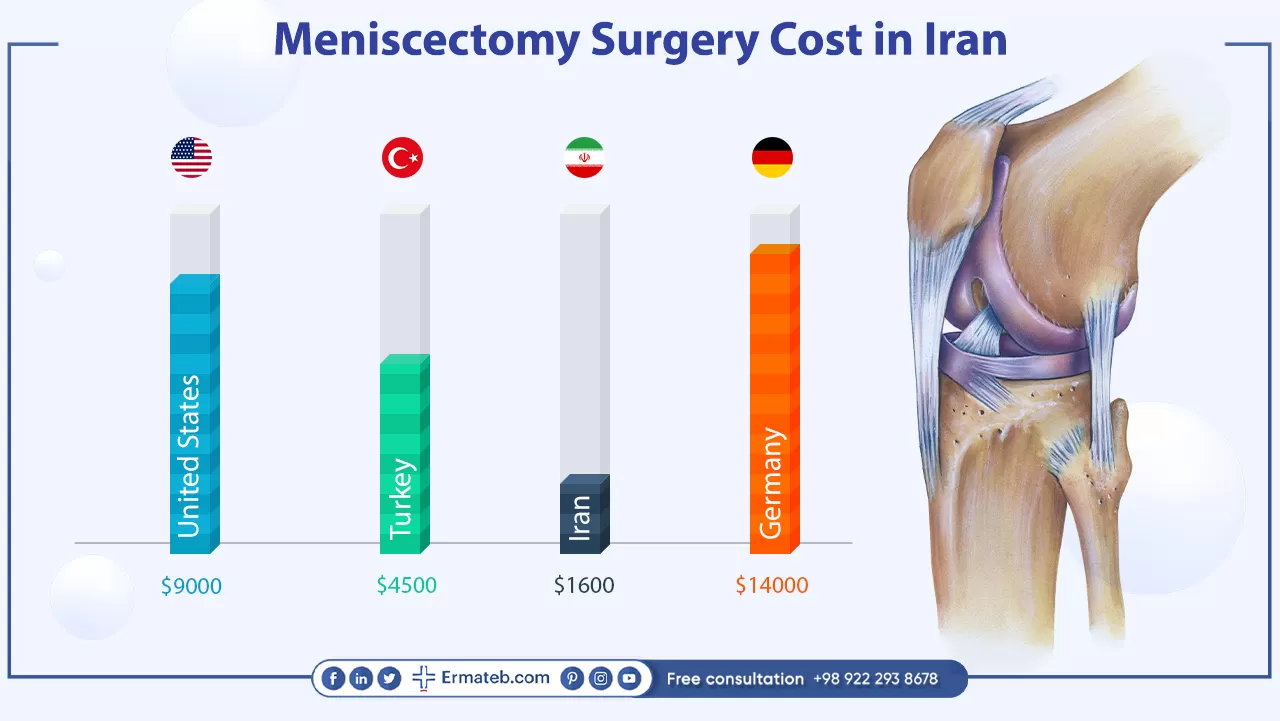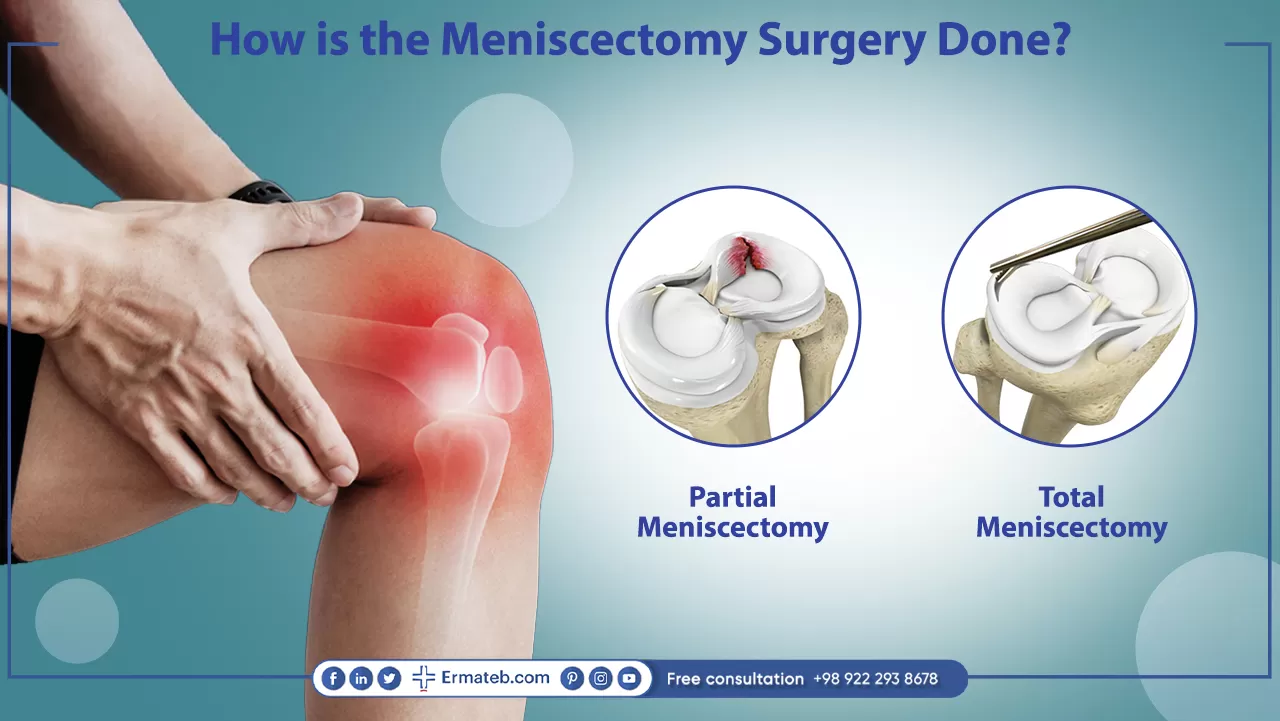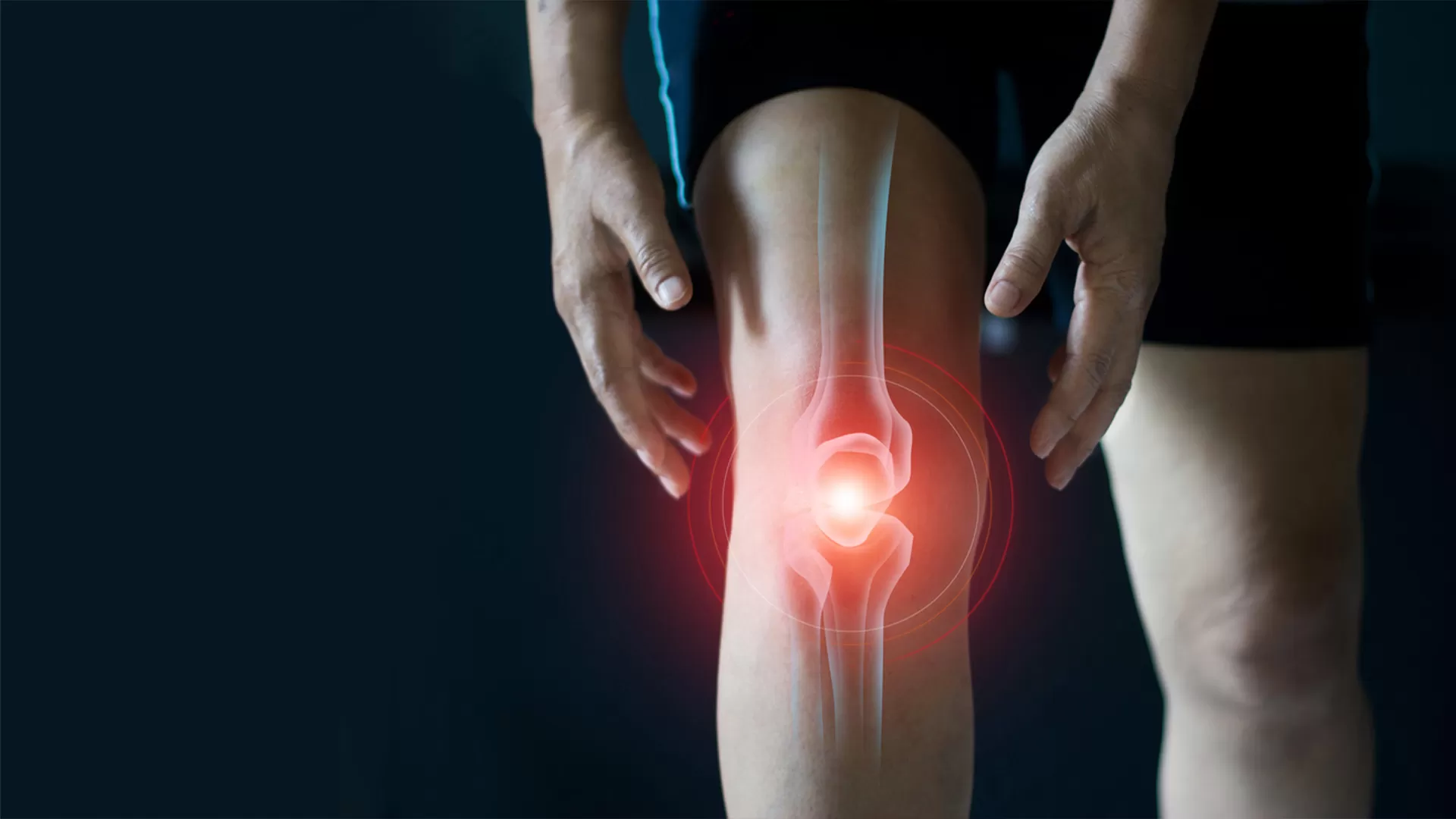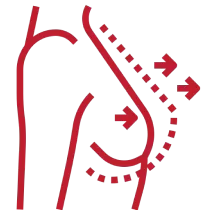Meniscectomy surgery cost in Iran

The cost of meniscectomy surgery in Iran can be different depending on some factors, including:
1.The type and complexity of your surgery (which can be partial or total, trimming or suturing)
2.The location and cost of living in the region where your operation is done
3.The type of medical facility used in your procedure (hospital or outpatient center)
4.The type of anesthesia used (which can be local, regional, or general)
5.The insurance coverage and extra expenses.
The average cost of meniscectomy surgery in Iran is $1,600, which is much more affordable compared to other countries due to the low currency of Iran. Mostly, international patients find the cost of the same surgery in the United States $9,000, $14,000 in Germany, and $4,500 in Turkey. That is why Iran is popular for its high-quality medical services at the most affordable costs.
If a patient has health insurance, they may pay much less for the surgery. The exact amount the patient pays will depend on the insurance plan and the provider they choose.
How is the meniscectomy surgery done?

Generally, there are two types of meniscectomy surgery which are partial and total. A partial meniscectomy eliminates only the damaged part of the meniscus. A total meniscectomy surgery, on the other hand, removes the entire meniscus. In most cases, a partial meniscectomy is preferred since it preserves more of the cartilage and decreases the risk of arthritis in the future.
A meniscus repair surgery is often performed as an arthroscopic surgery, which includes small incisions and a camera to guide the surgeon to see the inside of the joint on a monitor. After that, the surgeon trims or cuts the torn meniscus with the use of arthroscopic instruments. This reduces the damage to the surrounding tissues and can help the process of healing. Sometimes, an open procedure may be needed if the tear is too large or complex.
The surgical procedure can be performed under local or general anesthesia. It depends on the preference of the patient and the surgeon. The operation typically takes less than an hour, and most individuals can go home the same day.
Before meniscectomy surgery
Before the meniscectomy surgery in Iran, a person should follow some steps to prepare themselves and ensure a smooth surgery and recovery. Some of these tips are:
1.The person should talk to the doctor about the advantages, disadvantages, risks, and complications of the surgery, and what to expect during and following the surgical procedure.
2.The person should tell the doctor about all the medications and supplements they take, and ask if they need to stop any of them before the operation. Some medications, including blood thinners, may raise the risk of bleeding.
3.The person better do some exercises to strengthen their knee muscles and improve their range of motion. This helps the person recover faster and prevents stiffness and swelling. The doctor or physical therapist can recommend some specific exercises.
4.It is better to arrange for someone to drive you home after the operation, and to help you with daily activities for the first few days. The patient may need to use crutches or a walker for some time, so the patient should make sure they have them ready.
5.The patient must follow the doctor’s instructions about fasting before the operation. They may need to refrain from eating or drinking anything for several hours before the surgery.
6.The patient better take a shower or bath before the operation, and don’t apply any lotions, deodorants, perfumes, or nail polish. Don’t shave the surgical site since this may raise the risk of infection.
7.The patient better bring comfortable and loose-fitting clothes to wear following the operation. They may want to bring a pillow or a blanket for extra comfort.
Advantages and disadvantages of meniscectomy surgery
There are some pros and cons of this procedure that one should consider before making a decision.
Advantages:
1.The meniscus repair surgery decreases swelling, pain, and inflammation in the knee caused by the torn meniscus.
2.The operation can improve stability, mobility, and function of the knee, and let the patient resume normal activities and sports.
3.The operation can prevent further damage to your knee joint, including arthritis, by eliminating the loose fragments of the meniscus that can interfere with joint movement.
4.The operation is often performed by the use of an arthroscope, which is a minimally invasive technique that needs only small incisions and causes less tissue damage and scarring compared to an open procedure.
5.The operation is often performed as an outpatient procedure, which means the patient can go home the same day and have a faster recovery.
Disadvantages:
1.The operation may not completely relieve the patient’s symptoms or restore knee function, especially if the patient has other knee issues, like ligament injuries or osteoarthritis.
2.The operation may raise the risk of bleeding, infection, nerve damage, blood clots, or knee stiffness. These complications and side effects are rare, but they can be serious and need further treatment.
3.The operation may eliminate too much of the meniscus and can affect the shock-absorbing ability of the patient’s knee and lead to more wear and tear on the joint over time.
4.The operation may not be successful in repairing the meniscus and may result in recurrent tears or instability of the knee. The patient may need a revision operation or a meniscus transplant in the future.
What are the risks and complications of meniscectomy?
Meniscectomy just like other procedures has some potential risks and side effects. Some of the common risks and complications of meniscectomy surgery are:
1.Infection:
there is a risk of infection since bacteria can enter the knee through the incisions. Symptoms of infection involve increased pain, redness, swelling, warmth, and drainage from the wound. To treat the infection, antibiotics may be needed.
2.Bleeding:
Some bleeding is normal following the procedure; however, excessive bleeding can lead to swelling and pain in the knee. A blood transfusion may be required in some rare cases.
3.DVT (Deep vein thrombosis):
A blood clot may form in the leg vein and block the blood flow, which can cause pain, swelling, and warmth in the leg. If the clot breaks off and travels to the lungs, it causes a life-threatening condition which is called pulmonary embolism. Blood thinners may be prescribed in order to prevent or treat deep vein thrombosis.
4.Arthritis:
Eliminating part or all of the meniscus increases the wear and tear on the knee joint and leads to arthritis over time. Arthritis causes stiffness, pain, and decreased mobility in the knee. Anti-inflammatory medications, physical therapy, and joint replacement operations may be needed to manage arthritis.
5.Knee instability:
The meniscus can help stabilize the knee joint and prevent it from moving too much. Without the meniscus, your knee feels loose or wobbly, especially during some activities that include twisting or turning. This can raise the risk of further injury to the knee. Braces, exercises, and surgery may be needed to restore knee stability.
Meniscectomy surgery recovery period
The recovery period after a meniscectomy surgery depends on some factors, including the extent of the surgery, the patient’s age and health, and the activity level of the patient. In general, it takes around 4 to 6 weeks to resume normal activities, and around 3 to 6 months to return to sports or strenuous activities. Medication, physical therapy, and self-care measures can help the healing process and prevent side effects.
Patients can expect the following timeline:
On the day of the surgery, the patient will likely go home the same day as the operation, unless there are complications or the patient has other medical conditions. The patient will need someone to drive them home and help them with daily activities. The patient will have a bandage and a brace on their knee, and they may need to use crutches or a walker for some time. The patient will be given pain medication and instructions on how to prevent infection, how to care for the wound, and manage swelling. In addition, they will be advised to rest, ice, compress, and elevate (RICE) their knee regularly.
The first week after the procedure, the patient will have a follow-up appointment with the doctor to check the wound and eliminate the stitches. They will start physical therapy to regain the knee motion and strength. They’ll gradually increase their weight-bearing and walking and may be able to stop using a walker. The patient will still need to wear a brace and avoid twisting or bending their knee. They will also need to refrain from bathing, driving, swimming, and strenuous activities.
In the 2 to 4 weeks after the surgery, the patient will continue physical therapy and increase their range of motion and resistance exercises. They’ll be able to walk without a brace and resume some of their daily activities, like driving, showering, and working. They will still need to refrain from running, sports, jumping, and squatting. The patient will also need to protect their knee from injury and follow the doctor’s recommendations on when to return to sports or other activities.
In the 5 to 6 weeks after the surgery, the patient will progress to more advanced exercises and activities, including cycling, jogging, and swimming. They will also work on improving balance, coordination, and agility. The patient will be able to resume most of the daily activities, but they will still need to be careful and refrain from activities that put too much stress on their knee, like kneeling, deep squatting, or twisting. The patient will also need to maintain a healthy weight and lifestyle to prevent further damage to the knee.
In the 9 to 12 weeks after the surgery, the patient will reach the maximum recovery and be able to return to a pre-injury level of function and activity. They will be able to participate in sports and recreational activities, as long as they have the doctor’s clearance and they wear proper protective equipment. In addition, the patient will need to continue doing exercises to keep their knee strong and flexible and to prevent future injuries.


 Arabic
Arabic
 German
German
 Persian (Farsi)
Persian (Farsi)
 Russian
Russian
 Beauty
Beauty






 Medical
Medical




 Hotels
Hotels
 Hospitals
Hospitals






























![Frequently asked question about [name]](/v2tem/images/pages/service/faq-image.webp)
